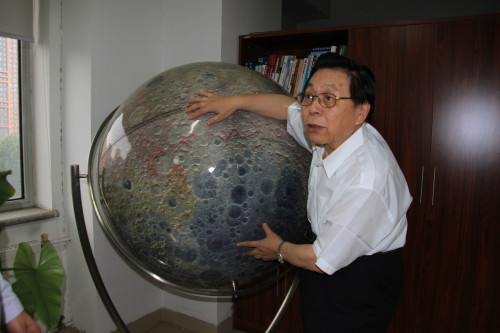
The Moon man: Ziyuan Ouyang in his office at the National Astronomical Observatories with a lunar globe covered with images taken by Chinese craft. (Courtesy: Mingfang Lu)
By Matin Durrani in Beijing, China
I caught up this morning on the second day of my visit to Beijing with Ziyuan Ouyang, chief scientist of China’s Moon programme at the National Astronomical Observatories, which lies not far from the city’s iconic “bird’s-nest” Olympic stadium.
I’d first met Ouyang on my last visit in 2011 when the country had so far launched two lunar missions – Chang’e 1 (which orbited the Moon for 18 months before crash-landing onto the lunar surface) and Chang’e 2 (another lunar orbiter that later moved off into interplanetary space).
China’s lunar efforts have continued and Ouyang explained to me what has happened since my last visit – and what the country plans to do next.
In 2013 China’s Chang’e 3 mission soft-landed on the Moon, its rover transmitting data about the lunar surface before signals stopped in April 2015. Like all Chinese lunar missions, it’s named after the country’s goddess of the Moon.
Next up, Ouyang explained, is Chang’e 5, which will be China’s first lunar sample-return mission. Due to take off next year, Chang’e 5 will drill a hole two metres deep in the lunar surface, scoop out at least a kilogram of Moon rocks and load them onto a capsule that will be fired back to Earth. The Russians and Americans have returned Moon rocks to Earth before, but this will be the first time Chinese scientists have pulled off that feat.
Carrying such a heavy payload back home will require clever ways of cooling and decelerating the craft as it re-enters the Earth’s atmosphere, but fortunately Chinese researchers last year launched a simulator to practise the maneouvre.
In 2018, meanwhile, China is planning to launch the world’s first ever mission to land on the far side of the Moon. In addition to a lander and rover, Chang’e 4 will consist of a satellite at the Earth–Moon system’s second Lagrangian point, meaning that it’s always facing the far side of the Moon and so can beam data back to Earth even though that part of the lunar surface is hidden from view.
Looking even further ahead, China wants to send a mission to Mars by 2020, using a lander and rover to study the Martian climate and create a map of the surface that’s more accurate than any other country has managed. Ouyang even claims the mission will seek ways of changing Mars’s climate to render it more suitable for potential human astronauts on the red planet.
Whether that’s possible I’m not sure, but you have to admire Ouyang – still going strong at the age of 81 – for thinking big.
Space exploration is too costly for individual nation.
It would be cost effective, if all the nations were contributing financially and share their scientific findings to this endeavor;that may invariably ensure the survival and propagation of earth’s life into the cosmos. However, greed,foolish nationalistic hubris coupled with imperialist ambitions might thwart this perspective.
Not true any more. Apollo was unsustainably expensive because everything was being done for the first time and on a very short timescale. But with half a century of experience, and new technology, space is far less expensive than it used to be. Multiple strands of exploration are affordable and offer greater variety and opportunity. Go China! And everyone else!